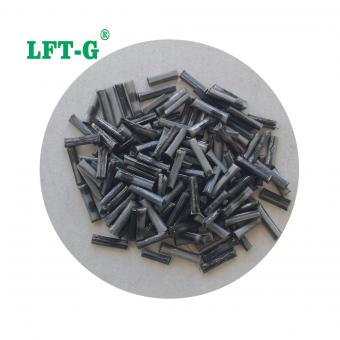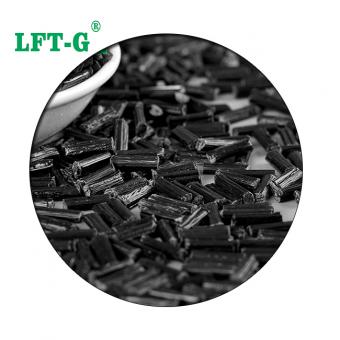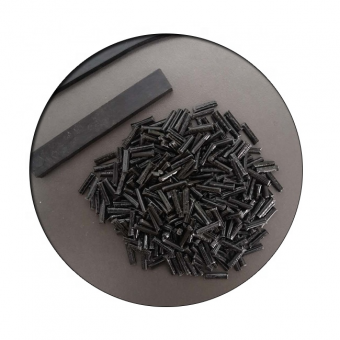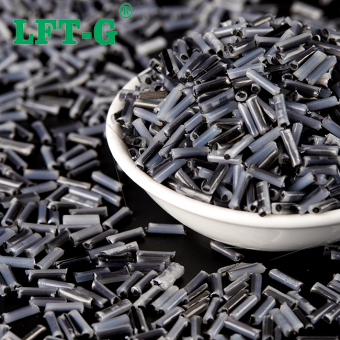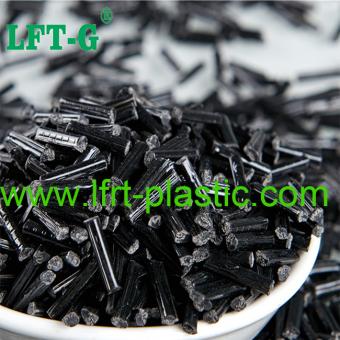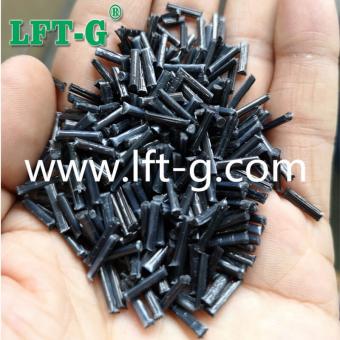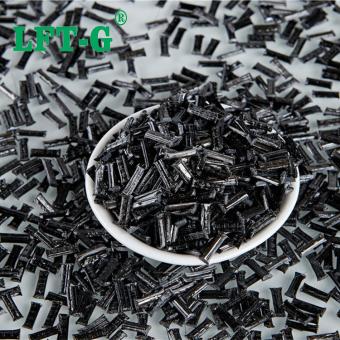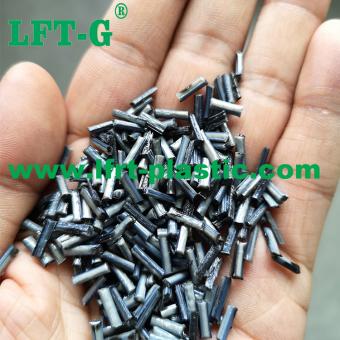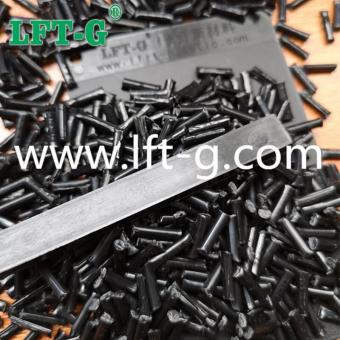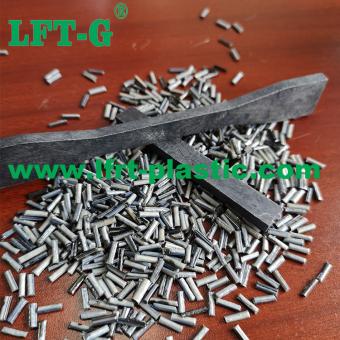-
Carbon Fiber PEEK Composite Injection ModingPEEK filling long carbon fiber reinforced thermoplastic for lightweight car parts.
- Carbon fiber PEEK granules
- Carbon fiber composite peek granules
- Plastic peek carbon fiber
- Black color peek carbon fiber granules
- Black color peek carbon fiber plastic
- Peek carbon fiber reinforced pellet
Tags :
-
Polyamide 6 filling carbon fiber granules for Scooter partspa6 lft manufactories polyamide nylon6 granules polymer
- polyamide long carbon fiber pellet
- injection mold PA6 lcf enhance material
- reinforced plastic PA6 polyamide granules
- polyamide carbon fiber granules for gear
- PA6 virgin granules filling carbon fiber
- Black color pa6 granules for axle
Tags :
-
LFT TPU long carbon fiber composite materials to make robot armsLFT TPU long carbon fiber composite materials to make robot arms
- Carbon fiber TPU
- LFRT TPU black color carbon fiber
- Long carbon fiber TPU composite
- Polyurethane TPU long carbon fiber
- Plastic Price TPU granules
- TPU composite materials
Tags :
-
PA6 Polyamide 6 fiiling Long Carbon Fiber composite indusrial raw material lcf40Product number: PA6-NA-LCF40 Product fiber: 20%-60% Product application: Suitable for manufacturing helmets, Car bumps and Robotic and arms etc. Product feature: High toughness, Light weight, High strength, Wear strength, Corrosion resistance, Creep resistance, Conduction, Heat transfer.
- Black color
- Heat transfer
- Sample available
- Customized products
- Manufacturing use
- Instead medal
Tags :
-
Hot sell PA66 composite material filling long carbon fiber polyamide 66 for aerospaceProduct number: PA66-NA-LCF50 Fiber specification: 20%-60% Product feature: High toughness, Light weight, High strength, Wear reisistance, Corrosion resistance, Creep resistance, Conduction, Heat transfer Product application: The wing of the aircraft, Duck wing, Stable wing, Nacelle and other aerospace fileds.view more
-
High temperature resistance PA12 long carbon fiber composite resin sports parts automotiveFiber specification:20%-60% Product grade:Narmal gradeview more
-
LFT-G PPS Polyphenylene sulfide composite long carbon fiber injection mold thermoplastic resin high toughnessPPS material In recent years, the application of special engineering plastics has gradually extended from the previous military and aerospace fields to more and more civil fields, such as automotive, equipment manufacturing, high-end consumer goods, etc.. Among them, polyphenylene sulfide (PPS) and polyether ether ketone (PEEK) are two special engineering plastics that have developed relatively quickly and have a wide range of applications. PEEK is superior to PPS in terms of strength, toughness, and maximum operating temperature. In terms of high-temperature resistance, PEEK is about 50°C higher than PPS. But on the other hand, the relatively obvious cost advantages and better processing properties of PPS make it more widely used. PPS is a crystalline, highly rigid white powder polymer, high heat resistance (long-term use of 200 ℃ -220 ℃, short-term can withstand high temperatures of 260 ℃), is a mechanical strength, rigidity, flame retardant, chemical resistance, electrical properties, dimensional stability are excellent resin. It has excellent wear resistance, creep resistance, flame retardancy and self-extinguishing properties. It maintains good electrical properties at high temperature and high humidity. Good flowability, easy to mold, almost no shrinkage and concave spot when molding. Good affinity with various inorganic fillers. It has been developed to shorten the difference between standard thermoplastic materials (e.g. PA, POM, PET ......) and advanced engineering plastics. PPS has the following distinct performance advantages: (1) Intrinsically Flame Retardant Unlike PC and PA, PPS pure resin and its glass fiber/mineral powder filled composites without any added flame retardants 可以轻松达到V-0@0.8mm甚至更薄厚度的V-0阻燃级别. Although PC and PA have a cheaper price and better mechanical strength (especially impact strength) than PPS, the cost of PC and PA composites with the addition of halogen-free flame retardant formulations (V-0@0.8mm级别) is significantly higher, in many cases even higher than PPS materials with the same mechanical strength. (2) Ultra-high flowability For the semi-crystalline PPS, its very high fluidity can allow glass fiber filling easily more than 50 %, while in the process of high-temperature melt blending extrusion, PPS compared to PC lower viscosity can make the glass fiber to withstand a lower degree of shear and extrusion, so that the final injection molded products have a longer retention length, to further enhance the effect of modulus. (3) Ultra-low water absorption This advantage is mainly for PA. In terms of fluidity, highly filled PA and PPS are comparable; and for mechanical properties, the same amount of filling PA composites will be more advantageous. But in addition to the halogen-free flame retardant limitations, another factor limiting the application of PA is its high water absorption: compared to high-temperature nylon PA6T 0.6%-1% water absorption, PPS 0.03% water absorption rate is almost negligible. The result is that PPS products due to water absorption and deformation of the product defect rate is much lower than the same conditions of PA products. (4) the unique metallic texture and higher surface hardness PPS injection molded parts will be dropped on the table, a very crisp sound unique to PPS crash. Through the special mold and reasonable mold temperature with the PPS injection molded parts in the human touch will also sound similar to the impact of metal, the surface will be as smooth as a mirror, with a metal-like luster. PPS-LCF compounds Length: About 12mm, or customized Color: Original color, or customized Fiber specification: 20%-60% Grade: General grade Long carbon fiber reinforced composites offer significant weight savings and provide optimum strength and stiffness properties in reinforced thermoplastics. The excellent mechanical properties of long carbon fiber reinforced composites make it an ideal replacement for metals. Combined with the design and manufacturing advantages of injection molded thermoplastics, long carbon fiber composites simplify the re-imagining of compoents and equipment with demanding performance requirements. Its widespread use in aerospace and other advanced industrials makes it a "high-tech" perception of consumers. Datasheet for reference Application Factory Q & A 1. Is there a uniform reference data for carbon fiber product performance? The performance of specific carbon fiber filaments is fixed, such as Toray's carbon fiber filaments, T300, T300J, T400, T700, etc. There are a series of parameters that can be traced. However, there is no uniform standard to measure the carbon fiber composite products. Firstly, the different models of raw materials selected will lead to different performance of the products, and then the different selection of substrate and product design will lead to different performance of the products. In addition to some common carbon fiber tube, carbon fiber plate and other conventional parts, most of th...
- PPS long carbon fiber injection
- PPS reinforced plastic LCF
- LFT-G PPS resin cf
- raw material pps with filler cf
- automotive parts plastic pps toughness
- black color pps fill long fiber
Tags :
-
LFT-G PEEK high quality modified materials fill long carbon fiber for automotives good performanceThroughout the plastics industry, PEEK is widely recognized as a leading high performance polymer (HPP). However, the preferred material in the automotive, aerospace, oil and gas, and medical device industries has long been metal, and PEEK polymers are rapidly changing that mindset. What is the PEEK material PEEK or Polyetheretherketone belongs to the class of polymers known as "aromatic polyketones" (more accurately Polyaryletherketone or PAEK). Research and development of PEEK began in the 1960s, but it wasn't until 1978 that Imperial Chemical Industries (ICI) patented PEEK, and Victrex PEEK polymer was first commercialized in 1981. "Aromatic" usually implies a distinctive or sweet flavor, which may seem like an odd term, but scientists use it to describe certain molecules that contain or consist of a cyclic structure (such as the aryl unit above). Small molecules of this type, such as toluene and naphthalene, have distinctive odors and hence the name. However, PEEK itself, like most thermoplastics, is odorless under normal conditions. Chemically, PEEK is primarily a linear semi-crystalline polymer. P comes from the Greek word "poly" meaning "many", so many EEKs form PEEK. aryl and ketone groups provide stiffness by being somewhat rigid, which means good mechanical properties and a high melting point. The ether group provides a degree of flexibility, while the aryl and ketone groups are chemically inert and thus chemically resistant. The regular structure of the repeating units means that the PEEK molecule can be partially crystallized and the crystallinity provides properties such as wear resistance, creep resistance, fatigue resistance and chemical resistance. The resulting polymer is widely recognized as one of the best performing thermoplastics in the world. Compared to metals, PEEK-like materials are lightweight, easy to mold, corrosion-resistant, and have a fairly high specific strength (strength per weight). Datasheet for reference When high performance is required, PEEK as the polymer of choice offers more than just two or three properties, it offers a wide range of excellent properties including: - High heat resistance Testing has shown that LFT-G's PEEK polymer has a continuous use temperature of 260°C (500°F). This allows for a wide range of applications in hot corrosive environments such as the process industry, oil and gas industry, and the engines and transmissions of countless vehicles.PEEK resists friction and wear in dynamic applications such as thrust washers and seals. - Chemically Inert PEEK resists damage caused by chemically corrosive working environments such as downhole environments in the oil and gas industry, and gears in mechanical and automotive applications. It is resistant to jet fuels, hydraulic fluids, de-icers and pesticides used in the aerospace industry for a wide range of pressures, temperatures and time frames. - Strong mechanical properties PEEK exhibits excellent strength and stiffness over a wide range of temperatures, and the specific strength of PEEK-like carbon fiber composites is many times higher than that of metals and alloys. "Creep" is the permanent deformation of a material under constant stress over a period of time. "Fatigue" is the brittle destruction of a material under repeated cyclic loading. Because of its semi-crystalline structure, PEEK has high creep and fatigue resistance and is more durable than many other polymers and metals over a long service life. - Does not ignite or burn easily PEEK has excellent flame resistance, with an ignition temperature of nearly 600°C. Even when ignited at very high temperatures, it does not burn continuously and emits little smoke. This is one of the reasons why PEEK is widely used in commercial aircraft. - Reprocessable and recyclable PEEK molecules are so stable that they can be melted and reprocessed time and time again with minimal impact on their properties. This helps to improve the environmental footprint and ensures more efficient reuse of waste materials generated during the manufacturing process. - And there's more! PEEK is also non-hygroscopic, so its properties are not altered in wet environments; it is resistant to gamma and electron beam radiation and is transparent under X-ray exposure, making it attractive for medical device applications.PEEK is also electrically stable and is typically used as an electrical insulator, but can be modified to become a conductor or static dissipative material. As a thermoplastic PEEK, it can be injection molded, compression molded and extruded using conventional thermoplastic processing equipment. It is very versatile and its use is becoming more and more common to improve component performance, durability, reduce weight and lower overall system costs over its lifetime. There is no doubt that it is replacing metals and alloys. In many industries and critical environments, material specialists, part designers and buyers must choose between PEEK and traditional metals a...
- High performancePEEK fiiler lcf
- Injection molded PEEK good price
- composite plastic peek black color
- made in China peek reinforced materials
- aerospace automotive parts plastic
- Low warpage PPS reinforced long carbon fiber
Tags :
-
Xiamen LFT-G Polyamide66 LCF filled wear resistance for auto partsPhysical properties of nylon materials Excellent mechanical properties: high mechanical strength, good toughness. Excellent self-wetting, wear resistance: small coefficient of friction, long service life as a transmission component. Excellent heat resistance: PA66 heat distortion temperature is very high, can be used for a long time at 150 degrees Celsius, PA66 after glass fiber reinforced, the heat distortion temperature of 252 degrees Celsius or more. Excellent electrical insulation properties: its volume resistance is very high, high breakdown voltage resistance, is an excellent electrical/electronic insulation materials. Introduction of Nylon66 filled LCF pellets PA66 is a high-performance engineering plastics, moisture absorption, poor dimensional stability of products, strength and hardness and metal. In order to overcome these shortcomings, as early as the 1970s, people use carbon fiber and glass fiber to enhance to improve its performance. PA66 reinforced with carbon fiber fiber materials in recent years the development of faster, because PA66 and carbon fiber are excellent performance in the field of engineering plastics materials, the composite material comprehensive embodiment of the superiority of the two, such as strength and rigidity than the unenhanced PA66 is much higher than that of the high-temperature creep is small, the thermal stability of a significant improvement in the dimensional accuracy of the good, wear-resistant. At present, PA66 carbon fiber composite materials are mainly short-cut or long carbon fiber reinforced particles, has been widely used in the automotive industry, sporting goods, textile machinery, aerospace materials and other fields. Carbon fiber is lightweight, high tensile strength, abrasion resistance, corrosion resistance, creep resistance, electrical conductivity, heat transfer, etc. It is very similar to glass fiber, but superior to glass fiber. Compared with glass fiber, the modulus is 3 times higher, which is a material with high rigidity and high strength. Datasheet of PA6-LCF for reference From the experiments of the technical department, we know that the bending strength, bending modulus of elasticity, impact strength and plane shear strength of the carbon fiber PA66 fiber-added material increase with the increase of carbon fiber content, transverse shear strength slightly decreased, overall the strength of the material has increased dramatically. Application of PA66-LCF Certificate Quality Management System ISO9001/16949 Certification National Laboratory Accreditation Certificate Modified Plastics Innovation Enterprise Honorary Certificate Heavy metal REACH & ROHS testing Factory & Lab Q & A 1. Is there a unified reference data for carbon fiber product performance? The performance of specific carbon fiber filaments is fixed, such as Toray's carbon fiber filaments, T300, T300J, T400, T700 and so on, there are a series of parameters can be traced. However, there is no uniform standard to measure the carbon fiber composite products. Firstly, the different types of raw materials selected will lead to different performance of the products, and then due to the choice of matrix and the different design of the products, it will lead to different performance of the products. In addition to some common carbon fiber tubes, carbon fiber boards and other conventional parts, most of the carbon fiber products in the production of the sample before the test to determine whether the performance of the product is in line with the use of the expected standard, and as a base point, so as to carry out the production and use of large quantities. 2. Are carbon fiber composite products expensive? The price of carbon fiber composite products is closely related to the price of raw materials, the level of technology and the quantity of products. Some products of the industrial environment requirements are high, the performance of carbon fiber products and materials have special requirements, which requires the selection of specific raw materials, raw materials, the higher the performance of the natural price of the more expensive, such as the application of orthopedic carbon fiber PEEK thermoplastic materials. Of course, the more complex the production process, the greater the working time and workload, and the production cost increases. However, the larger the order quantity, the lower the cost per piece, once the mass production of a particular carbon fiber product has been established. In the long run, the superior performance of carbon fiber will prolong the service life of the product, reduce the number of maintenance, and is also very beneficial to the reduction of the cost of use. 3. Are carbon fiber composite products toxic? Carbon fiber composites are made of carbon fiber filaments mixed with ceramics, resins, metals and other matrices, generally not toxic. For example, the above mentioned PEEK material is a food grade resin, this material has good compatibility...
- PA66 plastic raw materials injection molded
- PA66 recycled pure pellets
- long carbon fiber pa66 natural black color
- pa66 lcf granules instead metal polymers
- Low warpage electronic appliance
- auto part and aerospace parts
Tags :
-
LFT-G aerospace PEEK high strength and rigidity injection molded pelletsPEEK introduce PEEK can also be called polyether ether ketone, as a high-performance semi-crystalline plastics, such plastics have excellent chemical resistance, mechanical strength, dimensional stability and a series of good performance, according to the performance is divided into a variety of series of materials, the most common classification of PEEK materials are PEEK pure material, glass fiber or carbon fiber modification. PEEK Pure Material We can see that with an elongation at break of 15%, PEEK Pure, despite its high toughness, has a modulus of elasticity of only 4,200mpa, the lowest in the family of plastics. This relatively low modulus means that PEEK pure is 'softer' and less abrasion resistant than other PEEK modifiers. Therefore, if you are using PEEK pure in frictional working conditions, be aware of material loss due to wear of the material. PEEK filling Long Carbon Fiber Material PEEK LCF30 is a 30% longer carbon fiber filled plastic based on PEEK pure material, the carbon fibers increase the modulus compared to PEEK pure material while maintaining maximum toughness of the material PEEK CF30 is a material that maintains a very high level of stiffness and relatively high toughness. In addition, long carbon fiber modified PEEK exhibits excellent wear resistance and very good friction properties. PEEK LCF30 has better wear resistance compared to PEEK LGF30. Long carbon fibers conduct heat more efficiently. PEEK LCF30 is therefore suitable for sliding applications. Like PEEK pure resins, PEEK LCF30 has excellent hydrolysis resistance in steam and boiling water. The difference between LCF and SCF Staple fiber can also be called cut section fiber, staple fiber is obtained mainly by cutting off the chemical long fibers into a section of short fibers, so that the fibers formed are about the same length as natural fibers. Under normal circumstances, between 35-150 mm is called the length of staple fiber. In the composite material made of fiber is cut or pulled, the fiber is pulled from the matrix, such a pulling process is conducive to the absorption of energy provided by the loading, in a certain length range of the fiber, the longer the fiber, the greater the absorption of energy, and its strength is also more significant. And in the same volume amount, due to the longer the single fiber, the fewer the number of fiber roots, the less stress concentration generated at the fiber end, the more difficult the destruction of the material. From the results of the feedback of practical applications, the long carbon fiber reinforced thermoplastic composites of 6mm-24mm have more excellent various properties than the short fibers. In addition, carbon fiber reinforced composites in the friction process, the fiber body plays an important role in lubrication, long distance carbon fiber can be much more sustainable, stable lubrication, so the coefficient of friction is lower, less wear, and the formation of finer abrasive debris. Due to such advantages, long carbon fiber reinforced thermoplastic composites are not afraid of high frequencies and loads, and perform much better in practical applications. Application of PEEK-LCF materials
- Long carbon fiber Reinforced PEEK for electrial accessories
- Black color pellets PEEK sample available
- PEEK LCFR car parts 3D printer
- injection mold PEEK auto parts polymers
- Lightweight PEEK instead metal
- composite pellets Polymer granules
Tags :
-
Xiamen LFT-F Polyamide 6 filling Long Carbon Fiber composite engineering plastic 5-25mm lengthProduct number: PA6-NA-LCF40 Product fiber: 20%-60% Product application: Suitable for manufacturing helmets, Car bumps and Robotic and arms etc. Product feature: High toughness, Light weight, High strength, Wear strength, Corrosion resistance, Creep resistance, Conduction, Heat transfer.
- Black color pa6 LCF 20-60 injection molding
- Heat transfer high performance PA6
- Sample available compounds pa6
- Customized products polyamide can be recycled
- Manufacturing use pa6 thermoplastic resin
- Instead medal nylon 6 for home appliance parts
Tags :
-
Xiamen LFT-G Polyamide 66 composite material filling long carbon fiber reinforced pellets for aerospaceProduct number: PA66-NA-LCF50 Fiber specification: 20%-60% Product feature: High toughness, Light weight, High strength, Wear reisistance, Corrosion resistance, Creep resistance, Conduction, Heat transfer Product application: The wing of the aircraft, Duck wing, Stable wing, Nacelle and other aerospace fileds.
- Light weight pa66 compounds instead metal
- aerospace fileds high tech materials
- conduction nylon 6.6 carbon fibre
- Sample available can be customized pa66 lft
- Black color composite modified pa66 for car parts
- Thermoplastic material LFT-G injection molding pa6/6
Tags :

 e-mail
e-mail English
English français
français Deutsch
Deutsch русский
русский italiano
italiano español
español português
português العربية
العربية 日本語
日本語 한국의
한국의 中文
中文












